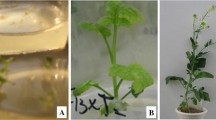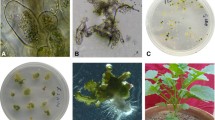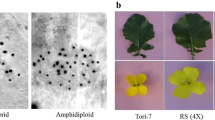Abstract
Researchers have conclusively shown that Sinapis alba (commonly known as yellow mustard) has many agronomic traits which would be beneficial if transferred to rapeseed ( Brassica napus L.). S. alba is resistant or tolerant to all major insect pests of Brassica crops in the Pacific Northwest region of the United States of America. It is also tolerant of high temperatures and drought stress, is shatter resistant and capable of high seed yield without the need for insecticides and herbicides. However, S. alba is considerably lower in oil content and lacks the high oil quality and seed meal quality of rapeseed (i.e. canola). This paper describes a combination of ovary culture and embryo rescue techniques used to develop fertile hybrid plants from the intergeneric cross between S. alba and B. napus . The hybrids were intermediate between both parents for presence of trichomes, leaf shape and color, seed size, pod shape, and seed oil content; showing expression of traits from both parental species. Hybrid plant tissue and seed contained all types of glucosinolate that exists in either B. napus or S. alba, at the same or higher level to the parental species. These hybrid crosses offer the potential for combining the desirable oil and glucosinolate qualities of B. napus with insect and disease resistance characters of S. alba.
Similar content being viewed by others
References
Bajaj, Y.P.S., S.K. Mahajan & S.L. Labana, 1986. Interspecific hybridization of Brassica napus and B. juncea through ovary culture, ovule and embryo culture. Euphytica 35: 103–109.
Brown, J., J.P. McCaffrey, D.A. Erickson, A.P. Brown, J.P. Harmon & J.B. Davis, 1996a. Yield reduction in Brassica napus, B. campestris, B. juncea and Sinapsis alba caused by flee beetle (Phyllolreta cruciferae (Goeze)) infestation (in press).
Brown, J., J.P. McCaffrey, J.B. Davis, B.L. Harmon, D.A. Erickson & A.P. Brown, 1996b. Yield reduction in Brassica napus, B. campestris, B. juncea and Sinapsis alba caused by late season insect infestation (in press).
Brown, P.D., M.J. Morra, J.P. McCaffrey & D.L. Auld, 1990. Glucosinolate degeneration in the soil. Amer Soc Agron, San Antonio, TX. pp. 245.
Brown, P.D., M.J. Morra, J.P. McCaffrey, D.L. Auld & I.L. Williams, 1991. Allelochemicals produced during glucosinolate degeneration in soil. J Chem Ecol Vol 17,No 10, pp. 2021–2033.
Brun, H., J. Plessis & M. Renard, 1987. Resistance of some crucifers to Alternaria brassicae (Berk.) Sacc. Proc Int Rapeseed Congress May 1987, Poznan, Poland.
Chevre, A.M., F. Eber, E. Margale & M.C. Kerlan, 1994. Comparison of somatic and sexual Brassica napus — Sinapis alba hybrids and their progeny by cytogenetic studies and molecular characterization. Genome 37: 367–374.
Clandinin, D.R., A.R. Robblee, J.M. Bell & S.J. Slinger, 1986. Composition of Canola meal. In: D.R. Clandinin (Ed.), Canola Meal for Livestock and Poultry, pp. 32. Canola Council, Winnipeg.
Daun, J.K. & I.D. McGregor, 1983. Glucosinolate analysis of rapeseed (canola). Methods of the Canadian Grain Commission Research Laboratory (2nd ed.). Agriculture Canada, Winnipeg. pp. 32.
Downey, R.K., G.R. Stringham, D.I. McGregor & S. Steffanson, 1975. Breeding rapeseed and mustard crops. In: J.T. Harapiak (Ed.), Oilseed and Pulse Crops in Western Canada, pp. 157–183. Western Cooperative Fertilize Ltd. Calgary, Alberta, Canada.
Downey, R.K. & G. Rakow, 1987. Rapeseed and mustard. In: W.R. Fehr (Ed.), Principles of Cultivar Development, pp. 437–486. Vol. 2 Crop species.
Fenwick, G.R., R.K. Heaney & W.J. Mullin, 1983. Glucosinolates and their breakdown products in food and food plants. Crit Rev Food Sci Dutr 18: 123–210.
Gareau, R.M., D.L. Auld & M. Heikkinen, 1990. Evaluation of seven species of oilseed as spring planted crops for the Pacific Northwest. Progress Report 227, Univ of Idaho, Ag Exp Station.
Harberd, D.J., 1969. A simple effective embryo culture for Brassica. Euphytica 18: 425–429.
Hemmingway, J.S., 1976. Mustards: Brassica spp. and Sinapis alba. In: N.W. Simmonds (Ed.), Evolution of Crop Plants. Longman Inc. NY.
Inomata, N., 1978. Production of interspecific hybrids in Brassica campestris × B. oleracea by culture in vitro of excised ovaries. 1. Development of excised ovaries in the crosses of various cultivars. Jpn J Gen 53: 161–173.
Jimenez-Osornoi, J.J. & A.R. Gliessman, 1987. Allele interference in a wild mustard (Brassica campestris L.) and broccoli (Brassica oler acea L. var italica) inter crop agroecosystem. In: Allelochemical Role in Agriculture and Forestry, pp. 262–288. Am Chem Soc
Lamb, R.J., 1980. Hairs protect pods of mustard (Brassica hirta cv Gisilba) from flea beetle feeding damage. Can J Plant Sci 60: 1439–1440.
Lichtenstein, E.P., D.G. Morgan & C.H. Mueller, 1964. Naturally occurring insecticides in cruciferous crops. J Agric Food Chem 12: 158–161.
Lui, H., 1985. Genetics and breeding of rapeseed. Shanghai Science and Technology Press.
Primard, C., F. Vedel, C. Mathieu, G. Palletier & A.M. Chevre, 1988. Interspecific hybridization between Brassica napus and Brassica hirta (Sinapis alba L.). Theor Appl Genet 75: 546–552.
Putnam, L.G., 1977. Response of four Brassica seed crop species to attack by the crucifer flee beetle, Phyllotreta cruciferae. Can J Plant Sci 57: 987–989.
Raney, J.P., H.K. Love, G.F.W. Rakow & R.K. Downey, 1987. An apparatus for rapid preparation of oil and oil-free meal from Brassica seed. Feet Wissenschaft Technologie/Fat Science Technology 6: 235–237.
Ripley, V.L. & P.G. Arnison, 1990. Hybridization of Sinapis alba L. and Brassica napus L. via embryo rescue. Plant Breed 104: 26–33.
Zenkteller, M., 1990. In vitro fertilization of ovules of some species of Brassicaceae. Plant Breed 105: 221–228.
Author information
Authors and Affiliations
Rights and permissions
About this article
Cite this article
Brown, J., Brown, A.P., Davis, J.B. et al. Intergeneric hybridization between Sinapis alba and Brassica napus. Euphytica 93, 163–168 (1997). https://doi.org/10.1023/A:1002905816887
Issue Date:
DOI: https://doi.org/10.1023/A:1002905816887




